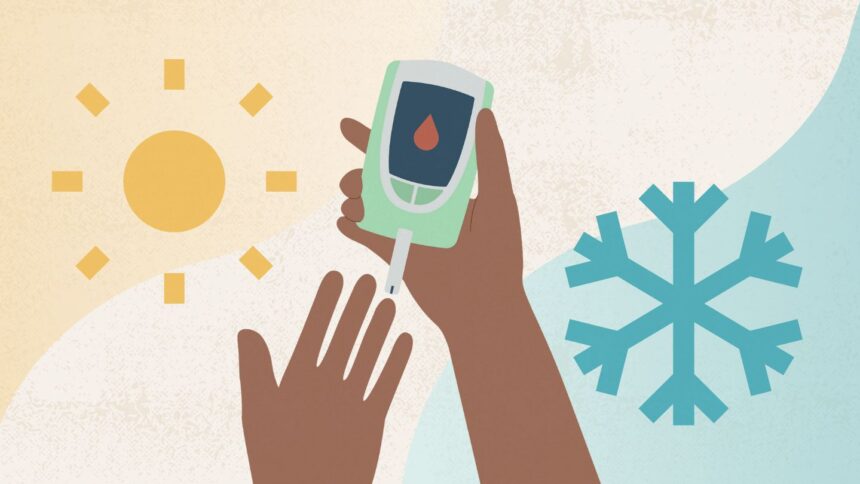So does blood sugar ranges when temperatures start to turn out to be uncontrollable. Excessive warmth or chilly seasons can have an effect on testing tools and drugs, each of which have a damaging impact on the physique’s capability to provide and use insulin.
Analysis printed in PLOS Drugs In 2018, hospitalizations for diabetic sufferers with both very excessive or low temperatures rose sharply. Different research have identified that amongst folks with diabetes, fever-induced deaths have a tendency to extend throughout heat months.
Nonetheless, there isn’t any have to have a bonus within the surroundings. Taking some clever precautions might help to cowl Mom Nature. Irrespective of the place you reside or what the climate forecast is, listed below are some changes to maintain you secure, wholesome and hold your diabetes administration plan on monitor.
6 ideas for managing diabetes in the summertime warmth
Observe these steps to make your blood sugar extra steady when the temperature rises.
1. Keep hydration
Excessive temperature means there’s a excessive likelihood of dehydration. It is an issue for everybody, but it surely has a transparent impact on folks with diabetes. “If you’re dehydrated, your blood sugar ranges can be increased as a result of there’s much less blood by way of your kidneys,” says Lori Roost, an endocrinologist at Mayo Clinic in Phoenix. “As a result of there’s little blood move, the kidneys don’t take away extra sugar from the blood and drain urine.” So, when it is sizzling, drink loads of water or sugar-free drinks. Do not wait till you are thirsty and refill your liquid.
2. Maintain your drugs correctly
Excessive summer time temperatures can have an effect on diabetes drugs, glucose meters, and diabetic take a look at strips. “It is easy for insulin and different medicine to deteriorate when it will get sizzling,” says Dr. Roost. Retailer your drugs correctly in excessive warmth. For instance, do not put them in your automobile on a swelling summer time day. “It could possibly be as much as 150 levels within the automobile,” warns Roost.
If you’re touring, do not forget to take kind 2 diabetes drugs. You might want to hold it with an ice pack on a cooler. In line with the Facilities for Illness Management and Prevention (CDC), be sure that they don’t seem to be sitting instantly on ice or ice packs.
3. Please steer clear of the warmth of the day
Train is a vital a part of diabetes administration and glycemic management. The American Diabetes Affiliation (ADA) recommends that you just obtain 150 minutes of bodily exercise every week. However you do not wish to train exterior through the hottest a part of the day. Outdated farmer yearbook. Definitely examine the native climate forecast. “You may get the primary train within the morning, or even when the solar goes down,” advises Angela Ginn, director of diabetes grants on the College of Maryland Medical Middle in Baltimore. An alternative choice is to train in an air-conditioned fitness center.
4. Understanding indicators of hypoglycemia
In line with the ADA, a number of the signs of fever fatigue are just like hypoglycemia or signs of hypoglycemia or hypoglycemia. “You may suppose it is a fever and you do not notice that your blood sugar ranges have dropped to a harmful low,” warns Rust. Watch out for warning indicators of hypoglycemia and hold carbohydrates to eat if you should elevate your blood sugar. There are plans for a medical emergency.
5. Ask the medical crew in regards to the frequency of blood glucose exams
When the climate is sizzling, you might want to check your blood sugar ranges extra ceaselessly. It will assist you to regulate your insulin and weight-reduction plan as wanted. In case you’re undecided about the perfect schedule, speak to your endocrinologist or licensed diabetes care and training professional in regards to the pointers, says Ginn.
6. Maintain your toes
Individuals with diabetes are extra inclined to foot issues, because the CDC factors out. In the summertime, you might be tempted to go barefoot or put on open sandals, however the CDC advises. As an alternative, they suggest sporting footwear that at all times match, not simply socks, even on a heat month. And on the finish of the day, rigorously examine your toes for cuts, scuffs, blisters or bruises. Do not ignore your foot accidents. Get therapy instantly.











